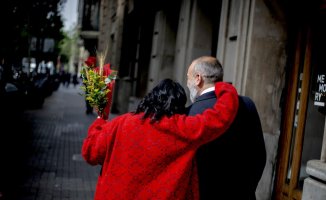The video went viral on Iranian social networks: a young blonde, with her back to the camera, is putting her hair up on a street in Karaj, a satellite city of Tehran. In the distance dozens of people can be seen. The camera follows the young woman, who has just done her bun, puts on her glasses and declares herself willing to participate in the mobilizations that have stirred up Iran. She never sees her face, a mask helps hide it, but she senses that she is quite young.
It was not many hours before his name was known: his name was Hadis Najafi, 20 years old. After having become one of the symbols that represent the courage of Iranian women, Hadis has also gone on to become one of the women who have ended up losing their lives fighting for what she thought was her right: to cover up or not. head. Several shots would have hit the young woman during the protests; her murder will possibly be one of many that will remain to be clarified in these and other previous protests.
Other photos of women, and also of men, who died this week circulate on social networks. The number of deceased varies according to each version, but it is estimated that it could be at least 50.
Hadis's family had to bury her quickly. The photo of her mother lying on her grave is another of the heartbreaking snapshots that have marked Iran since the tragic death of Mahsa Amini, a 22-year-old girl who was detained by the morality police while visiting Tehran. Her death was the trigger for these protests. The version of what happened has not yet been clarified despite the investigation ordered by President Ebrahim Raisi, but the hospital assured at the time that she had arrived brain dead.
The moral police maintain that the young woman had a heart attack, but her family argues that she was a healthy young woman and it is believed that she would have been raped in her captivity. Mahsa's family, like Hadis Najafi's, also had to bury her daughter in a hurry, under pressure from the authorities. A very different scenario from the burials that have been seen in recent days of members of the security forces, especially militiamen known as basijis, who have died as a result of clashes with protesters. As the days go by, the actions of both sides are becoming more violent.
At least two basijis have been buried in mass funerals where dozens of people have been allowed to participate, further increasing the division of society and its discontent. "There have been many years of abuse on their part - the Basijis, especially - of making life impossible for young people, and that hatred is seen in the streets," explains Sara, a sociologist who asks not to give her last name for safety reasons.
This woman, who is already old enough to have witnessed several protests, does not deny that there may be infiltrated elements, as has been argued in previous discontent mobilizations, but she and other people consulted confirm that these protests have a clearer profile. “In 2019 they were people from different sectors of society, especially workers, exhausted by the economic situation. They were faceless and there was a lot of vandalism seen, which caused doubts among a part of society, especially at the more educated levels,” she says.
The current protests are mostly led by young people, many of them women and under 20 years of age. “Young people who think this country has stolen their future,” says Sara. This scenario has created not only a debate in Iran about the future of the morality police but also about the continuation of the policy of imposing compulsory veiling.
From the very beginning of the revolution in 1979, women took to the streets to protest this rule, which some consider a political decision rather than a religious one.
For many, the regime rests on the backs of women. "It is the pillar on which the social principles of the Islamic Republic have been built, if they knock it down they fear that the system itself may fall," argues Vahid, a veteran journalist who asks that his name be changed. For many radicals, the veil is synonymous with the Islamic Republic, and they have come to say that burning the headscarf, as many young women have done these days, is an act against Islam. And so it should be punished.
But there are other opinions. Ayatollah Morteza Javad Amoli, in the conservative city of Qom, says it is a "strategic mistake" to deal with religious and cultural issues through security. Yesterday another lower-ranking cleric, Naser Naguvan, claimed that Iran has become the news of events in the world's major newspapers. "We put out a video and say it's not our fault, it fell on its own," he said.
Despite the debate, many fear that the repression and persecution of those who support the protests will increase even more in the coming days. At least 17 journalists have been arrested in the last nine days, including Nilufar Hamedani, the journalist for Sharq, the media outlet that first spoke about what had happened to Mahsa Amini. She was the first to report from the hospital and the first to speak to her family. She has learned that Nilufar has been able to call abroad from prison and has assured that she has been in an isolated cell and subjected to interrogation.













